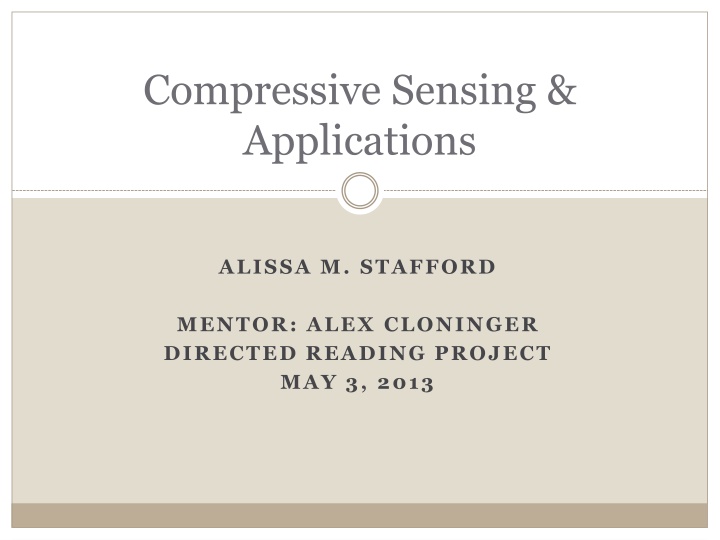
Compressive Sensing & Its Applications
Explore Compressive Sensing, a signal processing technique that acquires limited measurements to recover signals or images efficiently. Learn about the math behind it and the assumptions involved in this advanced technology.
Download Presentation

Please find below an Image/Link to download the presentation.
The content on the website is provided AS IS for your information and personal use only. It may not be sold, licensed, or shared on other websites without obtaining consent from the author. If you encounter any issues during the download, it is possible that the publisher has removed the file from their server.
You are allowed to download the files provided on this website for personal or commercial use, subject to the condition that they are used lawfully. All files are the property of their respective owners.
The content on the website is provided AS IS for your information and personal use only. It may not be sold, licensed, or shared on other websites without obtaining consent from the author.
E N D
Presentation Transcript
Compressive Sensing & Applications ALISSA M. STAFFORD MENTOR: ALEX CLONINGER DIRECTED READING PROJECT MAY 3, 2013
What is Compressive Sensing? Signal Processing: Acquiring measurements of a signal and using these measures to recover the signal Compressive Sensing Acquiring a limited number of measurements
What is Compressive Sensing? Signal Processing: Acquiring measurements of the brain and using these measures to recover an image of the brain Compressive Sensing Acquiring a limited number of measurements of the brain
What is the Difference? ~1/2 ORIGINAL measurements
Well, Wheres the Math? Ax=b y= x brain measurements NxN matrix
Well, Wheres the Math? y= x brain measurements MxN matrix
Is Everything Compressible? Sparse Compressible K-Sparse K non-zero coefficients Assume the brain is sparse
Any More Assumptions? y= x The measurements depend on What kind of is needed so the measurements are an accurate representation of x?
What kind of ? satisfies Restricted Isometry Property (RIP) For all x that are K sparse, If small, same logic implies no two completely different measurements will give same image
How Many Measurements? is MxN When satisfies RIP of order 2K with <sqrt(2)-1, M CK log(N/K)
How is Image of the Brain Recovered? is MxN not invertible Finding x is an optimization where z is in (y) Finds the sparsest x that is consistent with y But 0-norm is nonconvex difficult to solve 1-norm is convex
Take-Homes Compressive sensing is signal processing, only with a limited amount of measurements y= x, where is MxN and satisfies RIP M CK log(N/K) Use the 1-norm to find the sparsest x
References Baraniuk, Richard, Mark Davenport, Marco Duarte, Chinmay Hegde, Jason Laska, Mona Sheikh, and Wotao Yin. An Introduction to Compressive Sensing. Houston: Connexions, 2011. Print. Kendall, James. "2010S JEB1433 Medical Imaging." wikipedia. N.p., 3 May 2010. Web. 30 Apr. 2013. <wiki.math.toronto.edu/TorontoMathWiki/index.ph p/2010S_JEB1433_Medical_Imaging>.
